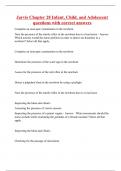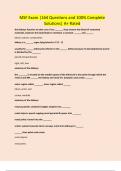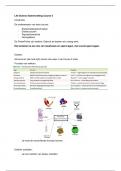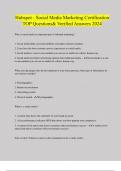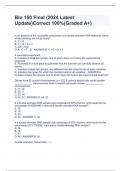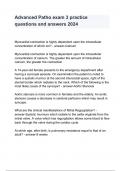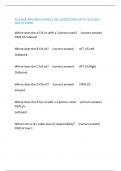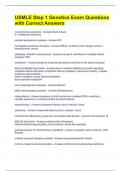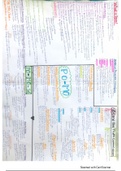Inhoud
Week 1 + 2 ..................................................................................................................................................... 2
Syllabus ...................................................................................................................................................... 2
Chapter 1 Molecular Networks and Systems Biology ...................................................................... 2
Chapter 2 Kinetic description of the biochemical reactions between molecules. ........................... 3
Lecture ....................................................................................................................................................... 5
Practical ...................................................................................................................................................... 5
Week 3 + 4 ..................................................................................................................................................... 6
Syllabus ...................................................................................................................................................... 6
Chapter 3 The remarkable and emergent functionality of small molecular circuits ........................ 6
Lectures .................................................................................................................................................... 10
Practical .................................................................................................................................................... 13
Week 5 + 6 ................................................................................................................................................... 14
Syllabus .................................................................................................................................................... 14
Chapter 6 Basic Enzyme Kinetics ................................................................................................... 14
Lecture Enzyme Kinetics .................................................................................................................... 20
Practical .................................................................................................................................................... 21
Week 6 ......................................................................................................................................................... 22
Book ......................................................................................................................................................... 22
Chapter 5.6.5 Molecular Networks and Systems Biology .................................................................. 22
Chapter 7 Enzyme kinetics examples ............................................................................................ 22
Lectures .................................................................................................................................................... 23
Week 7 ......................................................................................................................................................... 24
Book ......................................................................................................................................................... 24
Chapter 4 Diffusion and reactions ..................................................................................................... 24
Lecture ..................................................................................................................................................... 25
Notes Mathematica .................................................................................................................................. 26
1
,Week 1 + 2
Syllabus
Chapter 1 Molecular Networks and Systems Biology
Proteins can function as enzymes, regulators, perform structural roles or other activities.
Metabolic networks: assimilation and conversion of nutrients into building blocks for cellular components
(such as lipids, nucleic acid and amino acids). Building blocks can be converted further or polymerised by
enzymes into proteins, RNA, DNA and membranes.
Signal transduction and metabolism are typically fast. However, gene expression and protein turnover
may take minutes to hours.
Cells are organized systems, kept continuously in a state out of thermodynamic equilibrium by processes
that extract energy from nutrients. Cells are organized in space (organelles) and time.
Anabolism: responsible for the usage of energy to make macromolecules out of building blocks.
Glycolysis: conversion of sugars into building blocks and energy metabolites.
Main energy carriers: ATP, NADPH and NADH.
Allosteric activators/inhibitors: molecules which regulate the activity of enzymes, but they are not
produced/consumed during the reaction.
Crabtree effect: production of ethanol (alcohol) under aerobic conditions .
Glycolysis: glucose is converted into two molecules pyruvate(H3C3O2OH), 2 H ions and two H2O molecules.
Isogenic cells: cells with the same genetic make up. Isogenic cells can display large cell-to-cell
heterogeneity. E.g. cells can differ remarkably in levels of certain proteins.
Mutations alter properties of proteins and thereby whole networks.
Different network principles are found. All organisms rely on molecular networks and use similar
molecular regulatory mechanisms with a few recurring designs/principles.
2
, Chapter 2 Kinetic description of the biochemical reactions between molecules.
Throughout the chapter reactions between molecules will be described without considering diffusion of
molecules, spatial organisation of the cell and inherent stochastic aspects of reactions.
Molecule X with concentration x in terms of millimolar, mM. The concentration is: 𝑥 = 𝑛𝑥 /𝑉
𝑑
Rate of change in concentration is dx/dt. 𝑥(𝑡) = 𝑣𝑠𝑦𝑛𝑡ℎ (𝑡) − 𝑣𝑑𝑒𝑔 (𝑡) = ∑𝑖 𝑣𝑖,𝑠𝑦𝑛𝑡ℎ (𝑡) − ∑𝑗 𝑣𝑗,𝑑𝑒𝑔 (𝑡)
𝑑𝑡
For zeroth → 𝑋, first order 𝑆 ↔ 𝑋 and second order 𝑋 + 𝑌 ↔ 𝑋𝑌 reactions:
Reaction rate v, in units mM/min 𝑣=𝑘𝑥 𝑣 = 𝑘 + 𝑠 − 𝑘 −𝑥 𝑣 = 𝑘 + ∙ 𝑥 ∙ 𝑦 − 𝑘 − 𝑥𝑦
With rate constant k (in this case) min-1 𝑘 = [𝑚𝑖𝑛−1 𝑚𝑀] 𝑘 = [𝑚𝑖𝑛 −1 ] 𝑘 = [𝑚𝑖𝑛−1 𝑚𝑀 −1 ]
𝑛 𝑝 𝑚𝑗
𝑛1 𝑋1 + 𝑛2 𝑋2 + ⋯ + 𝑛𝑠 𝑋𝑠 ↔ 𝑚1 𝑌1 + ⋯ + 𝑚𝑝 𝑌𝑝 → 𝑣 = 𝑘 + ∏𝑠𝑖=1 𝑥𝑖 𝑖 − 𝑘 − ∏𝑗=1 𝑦𝑗
For 2𝑋 ↔ 𝑋2 𝑥𝑇 = 𝑥(0) + 2𝑥2 (0) = 𝑥(𝑡) + 2𝑥2 (𝑡)
𝑑𝑥 𝑑𝑥 𝑑𝑥
= −2(𝑘 + 𝑥 2 − 𝑘 − 𝑥2 ) = −2𝑣 because: + 2 2 = −2𝑣 + 2𝑣
𝑑𝑡 𝑑𝑡 𝑑𝑡
𝑑𝑥2 𝑑𝑥 𝑑𝑥2
= 𝑘 + 𝑥 2 − 𝑘 − 𝑥2 = 𝑣 thus: 0= +2
𝑑𝑡 𝑑𝑡 𝑑𝑡
𝑘 𝑑𝑥 𝑥(𝑡) 𝑡
Zeroth order reaction → 𝑋 with = 𝑘 and 𝑥(𝑡) = 𝑥(0) + 𝑘𝑡 (derive it with ∫𝑥(0) 𝑑𝑥 = ∫0 𝑘𝑑𝑡
𝑑𝑡
useful to calculate mRNA concentration, with the transcription activity = k.
𝑑 𝑥(𝑡) 1 𝑡
Exponential growth: 𝑥 = 𝑘𝑥 → ∫𝑥(0) 𝑑𝑥 = ∫0 𝑘𝑑𝑡
𝑑𝑡 𝑥
𝑥(𝑡) = 𝑥(0)𝑒 𝑘𝑡
𝑥(𝑡) ln 2
Doubling time 𝑥(0)
= 2 = 𝑒 𝑘𝑡𝑑 → 𝑡𝑑 = 𝑘
→ 𝑥(𝑡𝑑 ) = 𝑥(0)21; 𝑥(𝑔𝑡𝑑 ) = 𝑥(0)2𝑔
𝑑
Exponential decay 𝑑𝑡
𝑥 = −𝑘𝑥
𝑥(𝑡) = 𝑥(0)𝑒 −𝑘𝑡
1 −𝑘𝑡1 ln 2
=𝑒 2 → 𝑡1 =
2 2 𝑘
Zeroth-order synthesis and first-order degradation
𝑘1 𝑘2 𝑑𝑥 𝑘
→𝑋→ = 𝑘1 − 𝑘2 𝑥 𝑥(𝑡) = 𝑥(0)𝑒 −𝑘2𝑡 + (1 − 𝑒 −𝑘2 𝑡 ) 𝑘1
𝑑𝑡 2
𝑑𝑥 𝑘1
Steady state: 𝑑𝑡
= 0 and thus 𝑥 = 𝑘 ≡ 𝑥𝑠𝑡𝑒𝑎𝑑𝑦𝑠𝑡𝑎𝑡𝑒
2
𝑘
Analysing (𝑡) = 𝑥(0)𝑒 −𝑘2𝑡 + (1 − 𝑒 −𝑘2 𝑡 ) 𝑘1 you can conclude:
2
1. When you set the time to 0 then you obtain 𝑥(𝑡 = 0) = 𝑥(0), like you would expect,.
2. For very large times (𝑡 → ∞, 𝑜𝑟 𝑡 ≫ 1/𝑘2) then 𝑥(1) = 𝑥𝑠 . So, the system eventually attains a
steady state where: i. 𝑑𝑥 = 𝑑𝑡 = 0, ii. 𝑥 = 𝑥𝑠 , and iii. 𝑘1 = 𝑘2 𝑥𝑠 .
3. When 𝑘1 = 0, you get 𝑥(𝑡) = 𝑥(0)𝑒 𝑘2𝑡 indicating exponential decay.
4. When 𝑥(0) = 0 then the system simplifies to 𝑥(𝑡) = (1 − 𝑒 𝑘2𝑡 )𝑥𝑠 , which indeed gives 𝑥(0) = 0
𝑥(𝑡) 1 𝑘2 𝑡1 ln 2
and 𝑥𝑠
= 2=1−𝑒 2 and 𝑡1/2 = 𝑘2
. So, the half time for a system starting in a zero state is
1
determined by the life time of the molecule X, so by 𝑘 ! And, not by the synthesis time! This is
2
important to remember and many of you do not realise this.
𝑥(𝑡) = 𝑥(0)𝑒 −𝑘2 𝑡 + (1 − 𝑒 −𝑘2 𝑡 )𝑥𝑠 which stands for x(t) = (exponential decay + initial concentration) +
(combined synthesis and degradation and eventually xs is reached). So regardless of the initial condition,
steady state is always reached.
3

